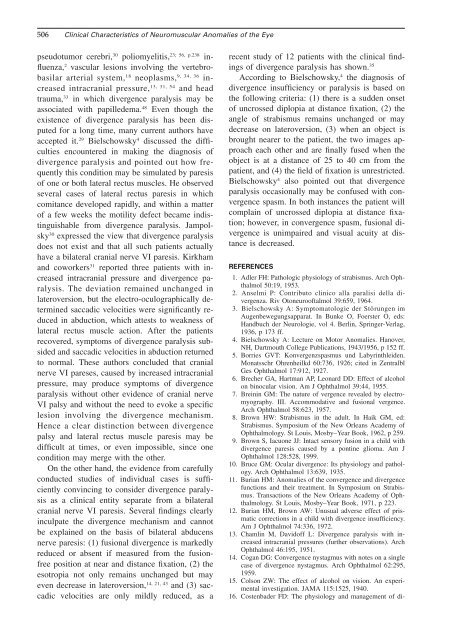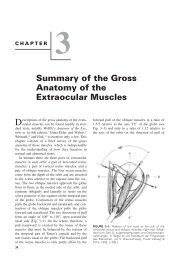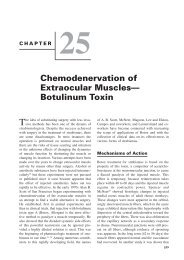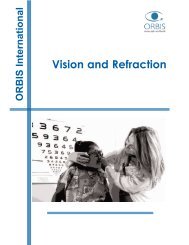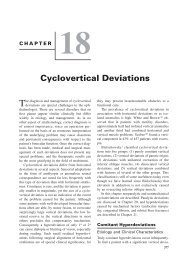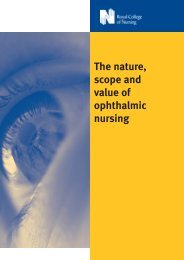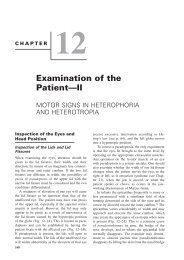Chapter 22: Anomalies of Convergence and Divergence
Chapter 22: Anomalies of Convergence and Divergence
Chapter 22: Anomalies of Convergence and Divergence
- No tags were found...
You also want an ePaper? Increase the reach of your titles
YUMPU automatically turns print PDFs into web optimized ePapers that Google loves.
506 Clinical Characteristics <strong>of</strong> Neuromuscular <strong>Anomalies</strong> <strong>of</strong> the Eyepseudotumor cerebri, 30 poliomyelitis, 23; 56, p.238 influenza,2 vascular lesions involving the vertebrobasilararterial system, 18 neoplasms, 9, 34, 36 increasedintracranial pressure, <strong>and</strong> head13, 31, 54trauma, 33 in which divergence paralysis may beassociated with papilledema. 48 Even though theexistence <strong>of</strong> divergence paralysis has been disputedfor a long time, many current authors haveaccepted it. 29 Bielschowsky 4 discussed the difficultiesencountered in making the diagnosis <strong>of</strong>divergence paralysis <strong>and</strong> pointed out how frequentlythis condition may be simulated by paresis<strong>of</strong> one or both lateral rectus muscles. He observedseveral cases <strong>of</strong> lateral rectus paresis in whichcomitance developed rapidly, <strong>and</strong> within a matter<strong>of</strong> a few weeks the motility defect became indistinguishablefrom divergence paralysis. Jampolsky30 expressed the view that divergence paralysisdoes not exist <strong>and</strong> that all such patients actuallyhave a bilateral cranial nerve VI paresis. Kirkham<strong>and</strong> coworkers 31 reported three patients with increasedintracranial pressure <strong>and</strong> divergence paralysis.The deviation remained unchanged inlateroversion, but the electro-oculographically determinedsaccadic velocities were significantly reducedin abduction, which attests to weakness <strong>of</strong>lateral rectus muscle action. After the patientsrecovered, symptoms <strong>of</strong> divergence paralysis subsided<strong>and</strong> saccadic velocities in abduction returnedto normal. These authors concluded that cranialnerve VI pareses, caused by increased intracranialpressure, may produce symptoms <strong>of</strong> divergenceparalysis without other evidence <strong>of</strong> cranial nerveVI palsy <strong>and</strong> without the need to evoke a specificlesion involving the divergence mechanism.Hence a clear distinction between divergencepalsy <strong>and</strong> lateral rectus muscle paresis may bedifficult at times, or even impossible, since onecondition may merge with the other.On the other h<strong>and</strong>, the evidence from carefullyconducted studies <strong>of</strong> individual cases is sufficientlyconvincing to consider divergence paralysisas a clinical entity separate from a bilateralcranial nerve VI paresis. Several findings clearlyinculpate the divergence mechanism <strong>and</strong> cannotbe explained on the basis <strong>of</strong> bilateral abducensnerve paresis: (1) fusional divergence is markedlyreduced or absent if measured from the fusionfreeposition at near <strong>and</strong> distance fixation, (2) theesotropia not only remains unchanged but mayeven decrease in lateroversion, 14, 21, 43 <strong>and</strong> (3) saccadicvelocities are only mildly reduced, as arecent study <strong>of</strong> 12 patients with the clinical findings<strong>of</strong> divergence paralysis has shown. 35According to Bielschowsky, 4 the diagnosis <strong>of</strong>divergence insufficiency or paralysis is based onthe following criteria: (1) there is a sudden onset<strong>of</strong> uncrossed diplopia at distance fixation, (2) theangle <strong>of</strong> strabismus remains unchanged or maydecrease on lateroversion, (3) when an object isbrought nearer to the patient, the two images approacheach other <strong>and</strong> are finally fused when theobject is at a distance <strong>of</strong> 25 to 40 cm from thepatient, <strong>and</strong> (4) the field <strong>of</strong> fixation is unrestricted.Bielschowsky 4 also pointed out that divergenceparalysis occasionally may be confused with convergencespasm. In both instances the patient willcomplain <strong>of</strong> uncrossed diplopia at distance fixation;however, in convergence spasm, fusional divergenceis unimpaired <strong>and</strong> visual acuity at distanceis decreased.REFERENCES1. Adler FH: Pathologic physiology <strong>of</strong> strabismus. Arch Ophthalmol50:19, 1953.2. Anselmi P: Contributo clinico alla paralisi della divergenza.Riv Otoneuro<strong>of</strong>talmol 39:659, 1964.3. Bielschowsky A: Symptomatologie der Störungen imAugenbewegungsapparat. In Bunke O, Foerster O, eds:H<strong>and</strong>buch der Neurologie, vol 4. Berlin, Springer-Verlag,1936, p 173 ff.4. Bielschowsky A: Lecture on Motor <strong>Anomalies</strong>. Hanover,NH, Dartmouth College Publications, 1943/1956, p 152 ff.5. Borries GVT: Konvergenzspasmus und Labyrinthleiden.Monatsschr Ohrenheilkd 60:736, 1926; cited in ZentralblGes Ophthalmol 17:912, 1927.6. Brecher GA, Hartman AP, Leonard DD: Effect <strong>of</strong> alcoholon binocular vision. Am J Ophthalmol 39:44, 1955.7. Breinin GM: The nature <strong>of</strong> vergence revealed by electromyography.III. Accommodative <strong>and</strong> fusional vergence.Arch Ophthalmol 58:623, 1957.8. Brown HW: Strabismus in the adult. In Haik GM, ed:Strabismus. Symposium <strong>of</strong> the New Orleans Academy <strong>of</strong>Ophthalmology. St Louis, Mosby–Year Book, 1962, p 259.9. Brown S, Iacuone JJ: Intact sensory fusion in a child withdivergence paresis caused by a pontine glioma. Am JOphthalmol 128:528, 1999.10. Bruce GM: Ocular divergence: Its physiology <strong>and</strong> pathology.Arch Ophthalmol 13:639, 1935.11. Burian HM: <strong>Anomalies</strong> <strong>of</strong> the convergence <strong>and</strong> divergencefunctions <strong>and</strong> their treatment. In Symposium on Strabismus.Transactions <strong>of</strong> the New Orleans Academy <strong>of</strong> Ophthalmology.St Louis, Mosby–Year Book, 1971, p <strong>22</strong>3.12. Burian HM, Brown AW: Unusual adverse effect <strong>of</strong> prismaticcorrections in a child with divergence insufficiency.Am J Ophthalmol 74:336, 1972.13. Chamlin M, David<strong>of</strong>f L: <strong>Divergence</strong> paralysis with increasedintracranial pressures (further observations). ArchOphthalmol 46:195, 1951.14. Cogan DG: <strong>Convergence</strong> nystagmus with notes on a singlecase <strong>of</strong> divergence nystagmus. Arch Ophthalmol 62:295,1959.15. Colson ZW: The effect <strong>of</strong> alcohol on vision. An experimentalinvestigation. JAMA 115:1525, 1940.16. Costenbader FD: The physiology <strong>and</strong> management <strong>of</strong> di-


